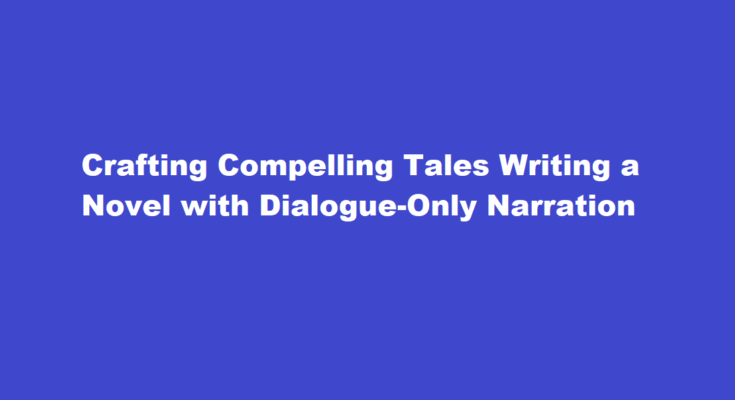Introduction
Writing a novel that relies solely on dialogue without descriptive narration is a challenging yet rewarding endeavor. By eliminating the conventional narrative elements, you can create a unique reading experience that engages readers’ imagination and pushes the boundaries of storytelling. In this article, we will explore the art of writing a novel using only dialogue, discussing the techniques, advantages, and potential pitfalls that authors should be mindful of.
Embrace the Power of Dialogue
Dialogue is the lifeblood of any story. It not only carries the plot forward but also reveals the characters’ personalities, emotions, and motivations. When you choose to forgo descriptive narration, your dialogue must be rich and dynamic. Each word must serve a purpose, advancing the story while leaving enough room for readers to infer the setting and emotions. Craft meaningful conversations that expose conflicts and inner thoughts, propelling the narrative through tension and resolution.
Character Distinctiveness
With no descriptive narration, the characters’ voices become paramount. Ensure each character has a unique speech pattern, vocabulary, and personality. Consider their background, beliefs, and social status, and let these elements reflect in their dialogues. This way, readers can easily differentiate between characters, fostering a deeper connection with the story.
Contextual Clues
Though devoid of descriptive narration, your dialogue can include contextual clues to give readers a sense of the setting and atmosphere. Contextual cues like the tone of voice, pauses, and reactions can provide vital information about the surroundings and the characters’ emotions. Utilize these cues judiciously to maintain a balance between revealing and concealing the narrative backdrop.
Pacing and Rhythm
A dialogue-only novel requires impeccable pacing and rhythm. The back-and-forth exchange of words should flow naturally, capturing the readers’ attention and keeping them engrossed in the story. Vary the length and style of dialogues to maintain a dynamic rhythm and prevent monotony.
Show, Don’t Tell
In traditional writing, authors use descriptive narration to show readers the world they’ve created. In a dialogue-only novel, you must master the art of “show, don’t tell” through conversations. Instead of directly stating emotions or actions, let characters express themselves through dialogue, allowing readers to draw their conclusions and immerse themselves in the story.
Subtext and Unreliable Narrators
Without descriptive narration, writers can effectively employ subtext and unreliable narrators. Subtext refers to the underlying meaning of conversations, often not explicitly stated by the characters. This adds depth to the story, allowing readers to explore the nuances and hidden motives behind the dialogues. Additionally, an unreliable narrator can create intrigue, leaving readers to decipher the truth within the character’s spoken words.
Introduce Variations
To maintain readers’ interest, introduce variations in the form of dialogue. Incorporate phone calls, letters, text messages, and even inner monologues in italics to break the pattern and provide insights into characters’ thoughts and emotions.
Engaging Dialogue Tags
Dialogue tags play a crucial role in a dialogue-driven novel. While descriptive tags are limited, using engaging and expressive dialogue tags can enhance the reading experience. Instead of relying on the mundane “he said/she said,” opt for alternatives like “whispered,” “exclaimed,” or “murmured,” which provide context without delving into extensive description.
FREQUENTLY ASKED QUESTIONS
Can you write a novel with only dialogue?
If what you’re giving the readers is only dialogue, you need to know what’s happening, the emotions, etc., and you need to make sure those events and emotions are adequately conveyed by the dialogue, that is – the reader can infer them from the dialogue.
Is it OK to start a chapter with dialogue?
The short answer is yes, starting your novel with dialogue is a viable option. There are many ways to open a story, and that’s one of them. But you want to do it in a way that helps the reader understand the story and its characters. You want to do it for the right reasons.
Conclusion
Writing a novel using only dialogue is a unique and daring undertaking that can captivate readers in unexpected ways. By focusing on crafting compelling conversations and using subtle contextual clues, writers can create a vivid and immersive experience without conventional descriptive narration. Balancing pacing, rhythm, and character distinctiveness will result in a narrative that challenges readers to engage their imagination actively. Remember, mastering this art may take time and practice, but with dedication, a dialogue-only novel can become an innovative and unforgettable literary work. So, embrace the challenge, experiment fearlessly, and let your characters’ voices paint the canvas of your story.
Read Also : Preserving The Present Creating a Time Capsule to Capture Our Era for Future Generations



